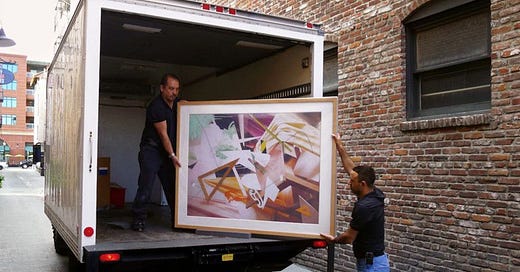Every month Less Than Half’s membership, the Matrons of the Arts, gets together for a webinar session with an art world professional.
This month, we met with Barbara Chamberlain, Director of Art Collection Management for Private Client Select, who gave us a tutorial on art insurance.
While it was planned in advance, the session felt tragically apt given the amount of property loss caused by the fires in LA.
So much of Less Than Half’s Matronage philosophy centers on equipping women collectors with good information so that they can collect from a place of power through knowledge— giving their support of women a strong foundation.
So what are some of the key takeaways from yesterday’s session on insurance?
Types of coverage
In order to protect your collection, you might opt for specialized insurance (beyond home owners/renters insurance). Depending on the value of your collection, you might opt for:
Blanket coverage: covers up to a certain amount in damage (say $100k), no matter what gets damaged.
Scheduled coverage: covers individual objects, as listed in the policy agreement. With scheduled coverage, you might insure only your most precious objects. For objects above $250k, this requires appraisals by certified appraisers.
Policies generally last a year.
Appraisals:
In order to ensure you’re properly insured, appraisals are necessary to determine the value of your objects (and therefore what insurance companies cover).
As a general rule of thumb, you should appraise:
-contemporary art every 2-3 years
-traditional art (with more stable markets) every 3-5 years
Less Than Half had a session with an appraiser in July— join the membership to get access to the recording!
Budgeting
Build being a good steward of your collection into your yearly art collecting budget. Consider the amount you’re willing to spend on art, and then divide that into the amount you’ll spend on art + the amount you’ll spend on taking care of the collection. Don’t leave insurance, collection management software, storage, and proper shipping as an afterthought.
Loans
If you’re loaning a work out, the museum or institution borrowing a work will have their own insurance policy, but it might not be adequate for your purposes. Make sure there is a loan agreement in place (you might have your own) to ensure the safety of your objects. (You might require, for example, that the art work not be hung by a window.)
Of course, that’s only a taste of what Barbara shared with us— if you wish you had been there, join the Matrons of the Arts here. Join at the Essentials level (only $1/day to learn the ropes of the art world!) or above for invitations to webinars.
Next month will be a tutorial on art logistics— how do you properly store, ship, and install work? It’s more complicated than it seems!
Until then—
xHall





